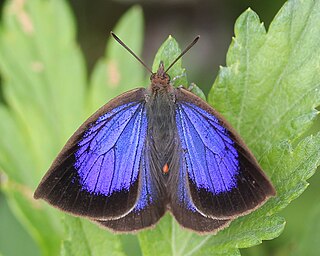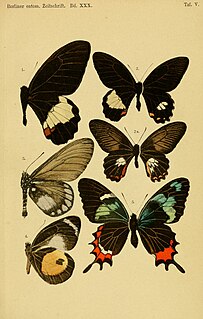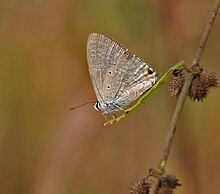
Eurema is a widespread genus of grass yellow butterflies in the family Pieridae.

Agrotis is a genus of moths of the family Noctuidae. The genus was erected by Ferdinand Ochsenheimer in 1816. A number of the species of this genus are extinct.

Arhopala is a very large genus of gossamer-winged butterflies (Lycaenidae). They are the type genus of the tribe Arhopalini. In the relatively wide circumscription used here, it contains over 200 species collectively known as oakblues. They occur from Japan throughout temperate to tropical Asia south and east of the Himalayas to Australia and the Solomon Islands of Melanesia. Like many of their relatives, their caterpillars are attended and protected by ants (myrmecophily). Sexual dichromatism is often prominent in adult oakblues.
Damias is a genus of moths in the family Erebidae. The genus was erected by Jean Baptiste Boisduval in 1832.

Euchromia is a genus of moths in the subfamily Arctiinae. The genus was erected by Jacob Hübner in 1819.
George Thomas Bethune-Baker was an English entomologist who specialised in Lepidoptera, especially those in the family Lycaenidae of butterflies.

Pithecops is a genus of butterflies in the family Lycaenidae erected by Thomas Horsfield in 1828.

Catochrysops panormus, the silver forget-me-not, is a small butterfly found from India to the Philippines and south to Australia that belongs to the lycaenids or blues family. The species was first described by Cajetan Felder in 1860.

Speyeria, commonly known as greater fritillaries, is a genus of butterflies in the family Nymphalidae commonly found in North America, Europe, and Asia. Some authors used to consider this taxon a subgenus of Argynnis, but it has been reestablished as a separate genus in 2017.

Phyllodes is a genus of moths in the family Erebidae. The genus was erected by Jean Baptiste Boisduval in 1832

Asota is a genus of moths in the family Erebidae first described by Jacob Hübner in 1819. Species are widely distributed throughout Africa, India, Sri Lanka, Myanmar, the Malayan region and tropical parts of the Australian region.

Macroglossum is a genus of moths in the family Sphingidae. The genus was erected by Giovanni Antonio Scopoli in 1777.

Hippotion is a genus of sphinx moths. The genus was erected by Jacob Hübner in 1819.

Yoma is a genus of nymphalid butterflies.

Cyrestis is a butterfly genus in the family Nymphalidae. They are known as map butterflies, so named because the wing-markings of some species resemble the lines of latitude and longitude of a world map. Cyrestis is a widespread genus ranging from Africa to parts of the Indomalayan realm and parts of the Australasian realm.

Papilio phestus is a species of swallowtail butterfly from the genus Papilio that is found on Solomon Islands, New Britain, New Ireland, New Hanover Island, and Admiralty Island.
Damias elegans is a moth of the family Erebidae first described by Jean Baptiste Boisduval in 1832. It is found in Australia (Queensland), New Guinea and on Waigiou, Aru and the Trobriand Islands.














